
Kanjini Co-Op Newsletter - Volume 4, Issue 1 - December 2012
Editorial
Welcome to Kanjini Co-Op's December 2012 Newsletter and a warm Hello to all newcomers. Thank you all for your contributions, continued interest and support!
Kanjini Co-Op Members and Directors have been very busy for the last three months and we are very excited right now.
That is because as of the 21-12-2012 (what an auspicious date!) Kanjini Co-Op is the proud owner of 7500 acres of paradise with 3km of crystal clear creek water, rich volcanic soils and a 20acre lake!!!
Yes we have been successful in securing our dream property!!!
As the property was available for only a very short time and another party offered the vendor a signed contract as well, we had our work cut out for us raising the necessary funds, and now many hundreds of hours later, that dream property has become a reality!
We nearly bought another property earlier this year, but twice our offers were refused.
It was very interesting observing and participating in the whole bevy of human emotions that surfaced as we went from property to property with bids and offers refused. Disappointments and fears had to be acknowledged and we all learnt a lot about emotions, expectations and acceptance.
You can read more about this AMAZING property below..... Kanjini Co-Op's first property - see Kanjini Co-Op Land below! AND we will put details and images onto our website in the coming weeks in our new section The Land, so keep an eye out for that...
We have welcomed NEW MEMBERS, Susanna, Monika and Chris who have joined because of the people involved in Kanjini, the structure and Vision of Kanjini Co-Op and also because of this particular property.
We have sadly farewelled Rafeek who was an Independent Director for many years and always an active contributor to the meetings and decision processes. We wish Rafeek all the very best in his new path down south. We also farewell Bob who has been a diligent meeting attendee as Chairperson for the past 3 years who departs due to pressing family commitments elsewhere.
2012 has been the United Nation’s International Year of the Co-operative. According to the University of Western Australia, this is a once in 25 year opportunity to acknowledge these important but often misunderstood businesses. (The Conversation 9th April 2012)
This is an acknowledgement by the international community that co-operatives drive the economy, respond to social change, are resilient to the global economic crisis and are serious, successful businesses creating jobs in all sectors.
"Co-operatives are a reminder to the international community that it is possible to pursue both economic viability and social responsibility."
Ban Ki-moon, UN Secretary General
Co-operatives and mutual enterprises are among the largest and oldest businesses in Australia. There are an estimated 1,700 co-operatives in Australia, most of which are small. However, in 2011 the top 100 co-operatives, mutual and credit unions in Australia had a combined annual turnover of more than AUD $14.7 billion.
Internationally the co-operative movement is estimated to provide employment for over 100 million people. In 2012 a study of the world’s 300 largest co-ops was undertaken by the International Co-operative Alliance (ICA). These organisations were found in 25 countries across Europe, North America and Asia. They had a combined annual turnover of over USD $1.6 trillion. This is equivalent to the world’s ninth largest economy.
Co-operatives have principles - Historically, the co-operative enterprise can trace its origins back at least to the 15th Century. However, the benchmark for the modern co-operative movement is the establishment of the “Rochedale Society of Equitable Pioneers” in 1844. Today these guiding principles remain at the core of what defines a co-op throughout the world. According to the International Cooperative Alliance, the seven guiding principles of co-operative enterprise are: voluntary and open membership; democratic member control; member economic participation; autonomy and independence; education, training and information; co-operation among co-operatives; and concern for the community.
At Kanjini Co-Op we also have our guiding principles. You can read about Kanjini Co-Op Values HERE.
BEES - "If the bee disappears from the surface of the earth, man would have no more than four years to live. No more bees, no more pollination...no more man." attributed to Albert Einstein
 As you may be aware Bees all over the world are suffering colony collapse for a variety of reasons - disease, pesticide poisons etc. I ask that you Please when ever you eat any bee products, honey, pollen, propolis etc be aware of the enormous amount of energy the bees expend so we can eat their food too AND support local bee keepers, thank you.
As you may be aware Bees all over the world are suffering colony collapse for a variety of reasons - disease, pesticide poisons etc. I ask that you Please when ever you eat any bee products, honey, pollen, propolis etc be aware of the enormous amount of energy the bees expend so we can eat their food too AND support local bee keepers, thank you.
You can read about some of the problems Bees are having in Australia HERE in an article Silence of the Bees in the online magazine Nature.
I mention Bees here because I have a passion and enthusiasm for Kanjini Co-Op to care for and be custodians of many BEES not only for our own honey and other products (as an income producing activity) but also for our orchards and other plant pollination.
We talked previously about Food Security which is an ever growing problem for thousands of people world wide. So another favour to ask - Please be aware of the amount of food that is wasted in your kitchen, especially over the festive season. It takes a lot of water and fertiliser and many hours of farmers time to grow these wonderful foods so lets respect. Startling figures released in The Conversation state that "The average Australian wastes 200kg of food a year - yet two million of us also go hungry."
Every one needs to eat and as healthily as possible as a top priority. At Kanjini we will grow as much of our own food as possible. We are also committed to establishing a large variety of Old World Vegetables and Fruits. More about this below in Nursery and Gardens.
Just in case you are short in time or do not want to read the whole newsletter, please at least check out the paragraphs about our Kanjini Co-Op Land, thanks.
And we hope to see you at our Hearts and Minds Meetings (see below).
Happy reading
Shiralee
Kanjini Co-Op Secretary
 Making Decisions
Making Decisions
We tend to think that if we disagree with someone, this automatically means there will be conflict, and that conflicts end with a winner and a loser or with wounded pride, as the expression goes. Let us avoid seeing things in this light. Let us always look for common ground. The key is to show immediate interest in the other's point of view. Surely this is something we can manage.
Dalai Lama, Daily Advice from the Heart
Kanjini Co-Op members and supporters have been making many decisions of late - Which property, what price, what value, which solicitor/which is the best land for the future growth of Kanjini etc..........
Some days I just did not want to have to make one more decision because there were so many. However knowing that a decision must be made and often to another person or organisations time-scale cleared the space for making that decision....
Making time to really feel what my heart was telling was the right decision helped me on those very mind type of days...
Always remember that making a decision is making a choice. Even saying I cannot decide is making a decision.....even non-action is a decision.....
The VERY BEST DECISION that Kanjini Co-Op has made is to forge ahead, despite the many obstacles that kept arising, we continued making decisions and making decisions and NOW WE HAVE THE LAND.
“We must make the choices that enable us to fulfil the deepest capacities of our real selves.”- Thomas Merton
Designing For The Future
"The thing always happens that you really believe in; and the belief in a thing makes it happen." - Frank Loyd Wright
Kanjini has a BIG Vision and an amazing future. We have been in the planning stage now since 2006 and we have achieved registration on 20-09-2009 and FINALLY acquisition of the land on 21-12-2012. These are big achievements for us and we are very pleased and proud. NOW the big planning can move forward as we now have the land and all those plans can be actualised.
At Kanjini Co-Op we are designing for a future that climatically may be very different than today's climate. All over the world agriculturalist have been recognising the changing climate and have researched and investigated options, designed new growing systems and become more efficient water users.
We are also designing a future where we move from individual consumerism to cooperative stewardship, and for a much more sustainable life-style.
If you have any interest to be involved in the planning on how best to manifest the Kanjini vision on the 'Adler Hill' property, please email us.
 Kanjini Co-Op Land
Kanjini Co-Op Land
On 21st December 2012 Kanjini Co-Op became the very happy owners and custodians of our Dream property, called 'Adler Hill'.
The property we just bought is full of superlatives and full of potential. 'Adler Hill' is a 7500 acre former pastoral holding (yes that is thirty square kilometres of land!) within an hours drive from Cairns and its international airport.
Most of the land is hilly to steep (going up to 1100 meters) and backs onto the Wet Tropics World Heritage. While there are some small patches of rainforest on the property, almost all of it is open dry forest. The land surrounds Emerald Creek falls and it is the first property on this permanent crystal clear creek flowing out of World Heritage. We hold a licence to pump up to 190 megs (millions of litres) of water from Emerald Creek which flows for about three kilometres through our land.
What we don't like so much is the high-voltage power-line going across the back section of the land, but it is easy to live well away from that.
In the picture on the right is the nice big dam which covers about twenty acres, big enough for sailing. There are fish and eels in the dam and sometimes hundreds of ducks and other bird life on it. There is also potential for several more dams on the property and the clean water we can pump from the river would be an asset to a possible aquaculture venture.
To give you an idea of the size of our 'Adler Hill' property, the western corner is about 2.5km past the hill in the distance just to the right of the dam wall (in above picture); the southern corner is behind the hills on the horizon straight across the dam; the south-eastern corner is the highest mountaintop behind the left back corner of the dam. The north-eastern corner is about a kilometre behind the camera.
Nearly half of the land is too steep even for grazing, most of the other half is usable only for grazing, but there are about 200 acres of good agricultural soils in several areas, from 5 to 40 acres in size. Not well suited to large-scale monoculture, but very well suited to growing a range of organic crops on a variety of soils and aspects (for ourselves and for sale).
As you can imagine there are many beautiful spots all over the property, many with stunning vistas.
We are sure that we will discover much more about this property as we spend more time there.
Talking about spending time there, at least for the next six month all we will be doing is camping there every now and then. The two houses are leased out until July 2013 and we have to honour those leases. Even then we might keep one or both tenants to keep helping to pay our loan and because we really want to build and live near the dam.
We have talked about first building an amenities block and maybe a shed or some other basic shelter near the dam, so if any of you have skills or ideas on how to design them with more sustainability in mind, please contact us.
There is also a lease over 39 acres to a large agricultural company, but they are no longer working that land.
We envision to start farming on other land (which has no poison history for decades) and if any of you have experience with growing crops or an interest to research which would be good organic cash crops for us to grow, please contact us.
What we will focus on first and foremost is to subdivide and sell four 100 blocks off on the north-western side, so that we can reduce our bank-loan.
These will all have about ten acres of rich dark volcanic soil and nice views. They will be ideal hobby farms or small commercial fruit farms. Emerald creek falls are only two minutes away and Mareeba (the biggest town on the tablelands) is about a ten minute drive.
So if you like the idea of Kanjini, but are not sure about sharing ownership of all major assets and prefer to own your own property, this might be your best chance to live close to us but still have your own property.
We intend to have these blocks ready for sale sometime after Easter and we plan to sell them around $300k each, let us know if you are interested.
In the next few weeks on our Kanjini.org website we will have a detailed description and some more photos of the property. You will also be able to do a virtual inspection of the property.
If you can offer any help with planning, advertising or researching or anything else, please fill out this questionnaire.
And if you are as excited about the 'Adler Hill' land as we are and want to become an equal owner, come up to meet us and get a feel for the land. Or you might feel like Monika, Chris and Susanna, who by joining us made this happen, that this land and this vision is what you want to support and be part of, in that case please fill out your membership application.
“Yesterday's thoughts have created your present. Today's thoughts are creating your future." (James Newman)
Spreading the Kanjini Vision
Now that we have the land, we need all the help we can get to manifest the Kanjini vision on it and to make Kanjini Co-Op as big and as beautiful as possible :-) So please continue to spread the Kanjini Co-Op Vision by telling your friends and neighbours, the florist, the fitness instructor, the nutritionist and the garden /farmer designers. Please also feel free to display flyers on local notice boards ........
We do appreciate your efforts and help in getting the word out there to those people :-) If you know of any groups you feel may be interested in Kanjini Co-Op or any publications or locations that would be suitable for advertising and or posters, please do let us know.
On our homepage are links to the hand-outs and notice board flyers , please feel free to print and hand them out or put them up on your local notice boards....thanks.
“The great thing in the world is not so much where we stand as in what direction we are moving. ( Oliver Wendell Holmes)
Frequently Asked Questions (FAQ's) !
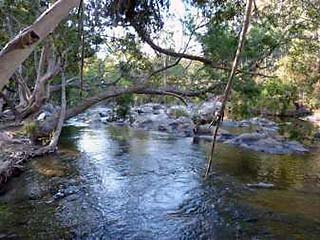 |
| Emerald Creek |
We are often asked questions and we are happy to share them here in the Newsletters. These questions and more, with our answers are also on-line.
Do any of your members have lives or activities outside of the Co-op?
Yes Members have lives outside the Co-Op. These may be businesses and income streams that are not located on Kanjini Land. And as we said above it will be while before we can start living on the land. Some members might not live on Kanjini land for a long time and just keep supporting Kanjini financially and by helping with planning, advertising and research and by contributing in meetings. Members also contribute to and participate in a variety of outside activities, organisations and leisure activities.
What type of accommodation is available?
Currently no accommodation is available as the only two dwellings on the land are currently tenanted until mid 2013. We aim to create amenities and some shelters as soon as possible and also commence building the Community House within 12 months (we need new members with share capital to do so). The level of accommodation will be determined subject to the amount of members and in accordance with Local Council Plans and Guidelines. Kanjini Co-Op will endeavour to provide a variety of accommodation styles which may depend on the amount of Share Capital a member has paid. When you have paid your share in full, then you can apply for additional investment shares and present your personal space/studio designs for approval.
However as Sustainability is a major component of the Kanjini Co-Op Vision then any separate personal spaces will need to be not only aesthetically pleasing and use sustainable materials but be simple and practical.
Kanjini Co-Ops emphasis is on reducing our footprint on our precious Earth. Therefore communal laundry/drying facilities, kitchens and general living areas will be shared.
Can I have my own business on Co-Op land?
Yes you can by applying for a usage agreement over the space which the business will be using. We want to see a variety of activities on the land. However we will give preference to Kanjini-operated businesses and encourage people to start those. Personal businesses are encouraged to employ Kanjni Co-Op members and/or should benefit Kanjini in other ways. However since the land is now purchased there are endless possibilities for businesses/ paid employment within Kanjini Co-Op owned business activities as well as opportunities for establishing privately owned income producing ventures on Co-Op land.
How can I fulfil my obligations as an Active member when I reside overseas three months every year ?
Kanjini Co-Op Active Membership requires that any Member shall contribute the equivalent of 10 hours per week in a variety of tasks. This is applicable only for the time spent on the property and not for the three month you are away. We have been talking about changing this so there is also a much smaller contribution for non-residents, but no decision has been made yet. If that eventuates you may work extra hours during your residence for example or arrangements can be made between you and another members (or possibly a non-member) to work on your behalf.
If you have any questions about Kanjini Co-Op please do contact us...we are always happy to answer your queries.
Heart and Minds Meetings
 These are our informal gatherings which are usually held on the last Sunday of each month form 11am to 5 pm with a shared lunch at 1 o'clock.
These are our informal gatherings which are usually held on the last Sunday of each month form 11am to 5 pm with a shared lunch at 1 o'clock.
The Hearts and Minds Meetings are designed to get to know each other better, introduce new interested people and advance the vision. These meetings are usually held at Koah and include Meet and Greet / introductions/ Q & A's, discussions and planning, all amidst lots of laughter and whatever else we decide to do together. There is always a Heart component with valuable sharing of feelings and if possible we all venture outside and in the gardens.
The Hearts & Minds Meeting in December will be on Sunday the 30th December 2012 at the Kanjini Co-Op Land. So if you would like to attend please contact us for directions. We will be back in Koah by 3pm, so if you cannot come to the land with us (sorry no Skype available there yet), you can join our meeting through Skype at 3pm.
For more info read Kanjini Co-Op Land...
Our Hearts and Minds Meetings are valuable experiences for cooperative living and much fun is had by all. If you are unable to physically attend a meeting but would like to contribute we can arrange for you to participate via SKYPE or by speaker phone. If you would like to use SKYPE or phone to attend, please let us know. We will need your SKYPE Name so we can have a trial connection prior to the meetings, thank you. Our SKYPE name is kanjini.cooperative
Besides these Hearts and Minds meetings we also hold our monthly formal Kanjini Co-Op Directors and Members meetings. Interested persons are invited to attend our monthly Directors and Members meetings (however only directors may vote). You are most welcome to join the process, ideas and your input is always welcome. Please Contact Us for dates and venue directions.
Please note that newcomers are encouraged to please first come to a Hearts and Minds meeting. Those are less formal and allow more time for questions and get-to know each other.
If you wish to receive email notices of all Director Meetings, please reply to this email with "Directors Meetings" in the Subject line, thank you.
Everyone on our email list will get informed of each Hearts and Minds Meeting. So if you know anyone who might be interested, please ask them to subscribe now.
Nursery and Gardens
Nursery and Gardens: One of the aims of Kanjini Co-Op is to achieve sustainable Food Security for our Members. We continue to experiment and grow a wide variety of plants for food, medicines, health products, home cleaning agents, insecticides, fungicides and for weed control. Our food and timber plant nursery and gardens continue to expand thanks to the help from wonderful wwoofers this past year. The last wet season provided us with a variety of wonderful foods; pumpkins, spinaches, herbs and Rosella fruits. We also had a bountiful crop of Brazilian Cherries and our first Isabella Grapes and now the Asparagus is harvest-able. Delicious! We have also had a bountiful winter garden, the major growing season and the gardens and delicious meals have been enjoyed by all. Winter this year graced us with our own home grown Water Chestnuts - truly delicious and so very easy to grow!
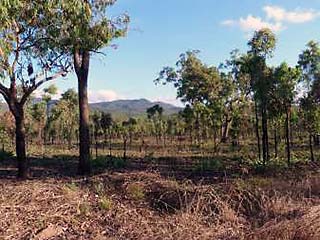 |
| One of the Subdivision Blocks |
Rosella: Hibiscus sabdariffa is a native of tropical West Africa and it prefers warm climates. Rosella is an attractive annual shrub to 1.5 m high with large, lobed reddish leaves and attractive yellow hibiscus-like flowers. Rosellas are easy to grow, with no pest problems, hardy and productive. The large flowers produce a crimson enlarged calyx. We use the fleshy red calyx to make jam or jelly, fruits in syrup, delicious drinks and also used in salads. The green seed pod provides the pectin for the setting of the syrup,jam and jellies. When dried these large red fleshy calyx are a major component of Red Zinger Herbal Tea and Hibiscus and Fruit teas! The tea is very similar in flavour to rose-hips and high in vitamin C. Seeds are roasted and ground into flour. Young leaves can be steamed or stir-fried and are known as Red Sorrel in the Pacific.
Ceylon Spinach: Ceylon Spinach or Malabar Greens (Basella alba F. Basellaceae) is an easy to grow perennial plant rich in chlorophyll, a valuable blood building component, which also provides favourable intestinal flora, digestive enzymes, and stimulation of secretions of the stomach, liver and pancreas. The mucilaginous leaves are valued for removing mucus and toxins from the body. It is an ideal greens to use in the tropical climates and hot summer, as its high water content is cooling to the body and has the effect of clearing the complexion and dealing with fluid retention. In Sri Lanka it is one of the basic herbal medicines given for insomnia and nervous breakdown. Leaves are used as a poultice on the forehead to relieve headaches, and bandaged over ulcers and eczema. The species Basella rubra, with red stems and red/green leaves has been a folk medicine for cancer treatment. Young, small tip leaves are tasty in salads, tucked into sandwiches and used as a garnish. Fresh, young leaves have a varying taste to different people; some people say they taste like fresh garden peas, others say like sweet-corn, fresh beans or lettuce. Large leaves are lightly steamed, sliced and tossed in stir-fries, added to quiche, soups, curries and casseroles. The tender tips of stems are lightly steamed and resemble asparagus in flavour. Flowers can be eaten. The juicy, purple berries can be used to colour jellies, sweets, drinks and for face painting. The addition of a little lemon juice makes the dye more effective. Typical of leaf vegetables, Ceylon spinach is high in vitamin A, vitamin C, iron, and calcium. It is low in calories by volume, but high in protein per calorie. The succulent mucilage is a particularly rich source of soluble fibre. Among many other possibilities, Ceylon spinach can be used to thicken soups.
Arrowroot: Canna edulis, often called Queensland arrowroot is a very hardy, clump-forming perennial plant with thick stalks and large bright green leaves 300-600mm long to 2m high. The tubers are best harvested to eat when still small, about the size of a tennis ball and the skin is still white. They can be used all year round, as a potato substitute. They can be chipped, baked, steamed and added to soups. Young tubers have the best flavour, older ones are fibrous. They taste a little like water chestnut. With a little preparation you can make your own arrowroot flour. The tuber has a high potassium content and 1-3% protein; the young leaves and shoots are nutritious and contain 10% protein. Arrowroot is a multi-purpose plant. It can be used to create shade and shelter around garden beds. It's brilliant for making compost and mulch. But the best part is eating arrowroot. Simply wash and slice them then soak in cold water for four hours to remove the starch. Slowly roast them so they are soft and sweet, rather like parsnips.
Sweet Potatoes:Sweet potatoes, (Māori call it kumera) are originally a native of South America and are an important starch staple in the Pacific Islands. Their botanical name is Ipomoea batatas and the flowers resemble those of Morning Glory. They're equally pretty and short lived. It is a dicotyledonous plant that belongs to the family Convolvulaceae. Its large, starchy, sweet-tasting, tuberous roots are an important root vegetable. The young leaves and shoots are eaten as greens in the Pacific Islands and New Guinea. Of the approximately 50 genera and more than 1,000 species of Convolvulaceae, Ipomoea batatas is the only crop plant of major importance. The sweet potato is only distantly related to the potato (Solanum tuberosum). The plant is a herbaceous perennial vine, bearing alternate heart-shaped or palmate lobed leaves. The edible tuberous root is long and tapered, with a smooth skin whose colour ranges between yellow, orange, red, brown, purple, and beige. Its flesh ranges from beige through white, red, pink, violet, yellow, orange, and purple. You can use sweet potatoes in the kitchen just like you would use potatoes. Boil them, steam them, mash them, fry them... But sweet potatoes have more uses: Young sweet potato shoots and leaves are yummy in stir fries and salads. Sweet potatoes also make a wonderful quick growing ground cover. You can use them as a living mulch and to keep weeds down.
Water Chestnut: The Chinese water chestnut (Eleocharis dulcis; synonyms E. equisetina, E. indica, E. plantaginea, E. plantaginoides, E. tuberosa, E. tumida), more often called simply the water chestnut, is a grass-like sedge grown for its edible corms. The water chestnut is actually not a nut at all, but an aquatic vegetable that grows in marshes, underwater in the mud. It has tube-shaped, leafless green stems that grow to about 1.5 metres.
The small, rounded corms have a crisp white flesh and can be eaten raw, slightly boiled, or grilled, and are often pickled or tinned. They can also be stored in water in refrigeration for up to 2 months!
They are a popular ingredient in Chinese dishes. They can also be ground into a flour form used for making water chestnut cake, which is common as part of dim sum cuisine. They are unusual among vegetables for remaining crisp even after being cooked or canned, because their cell walls are cross-linked and strengthened by certain phenolic compounds, like oligomers of ferulic acid.
Raw water chestnuts are slightly sweet and very crunchy. Boiled water chestnuts have a firm and slightly crunchy texture, with a flavour that is very mild and slightly nutty, so it is easily overpowered by any seasoning or sauces. Water chestnuts are often combined with bamboo shoots, coriander, ginger, sesame oil, and snow peas. They are delicious in Stir fries a swell!
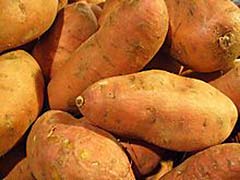 Sweet Potatoes |
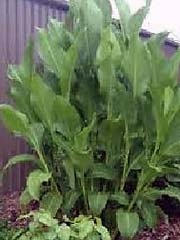 Queensland Arrowroot |
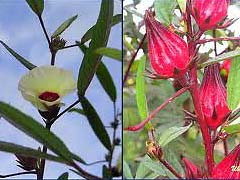 Rosella |
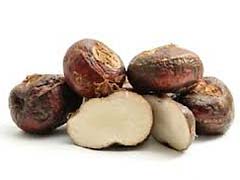 Water Chestnuts |
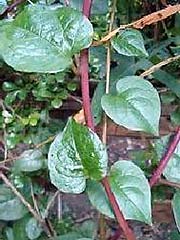 Ceylon Spinach |
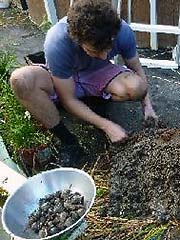 Chris harvesting Water Chestnuts |
News & Quote of the Day
BREAKING NEWS: Ancient fertile plants brought back to life from Siberian permafrost. (February 2012).
Nature is stranger than we can imagine.
Using tissue culture, whole plants have been regenerated from fruit buried by an Arctic squirrel in Siberian permafrost 30,000 years ago. It's believed that the squirrels' burrows aided preservation of the Silene stenophylla material, freezing it quickly and preventing thawing prior to discovery. These deposits may be a source of ancient germ-plasm of other plants for future research. You can read the abstract of the Proceedings of the National Academy of Sciences paper here: Regeneration of whole fertile plants from 30,000-y-old fruit tissue buried in Siberian permafrost.
QUOTE OF THE DAY:
“Your good intention is not enough... your willingness is everything!" (A Course in Miracles)
This is it from us until the next newsletter .....
We wish you ALL a Prosperous and Joyful 2013 ...
.....from Shiralee and The Kanjini Co-Op team
Please feel free to ask your friends to subscribe to our newsletter by contacting us (with SUBSCRIBE in the subject line) |